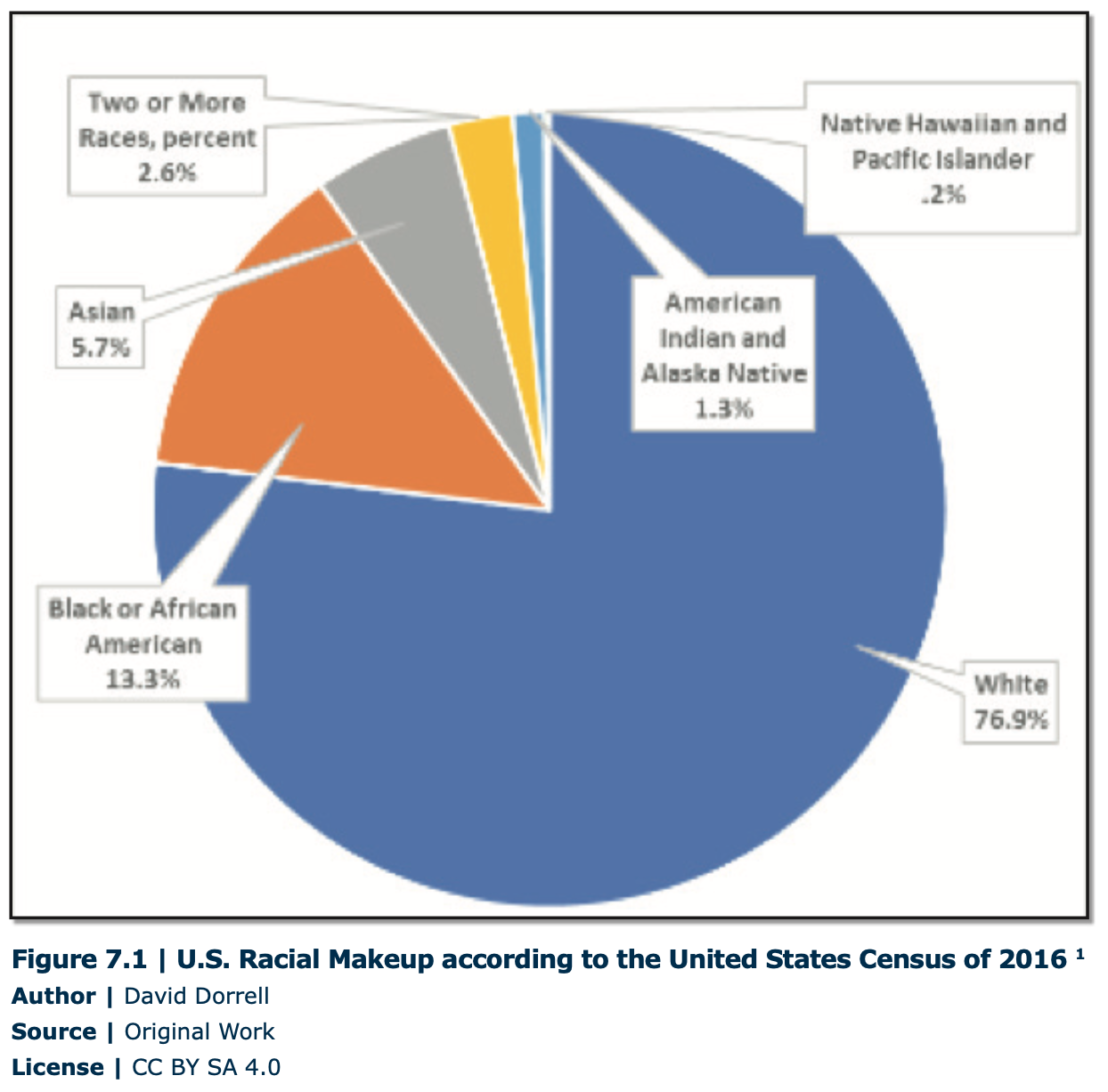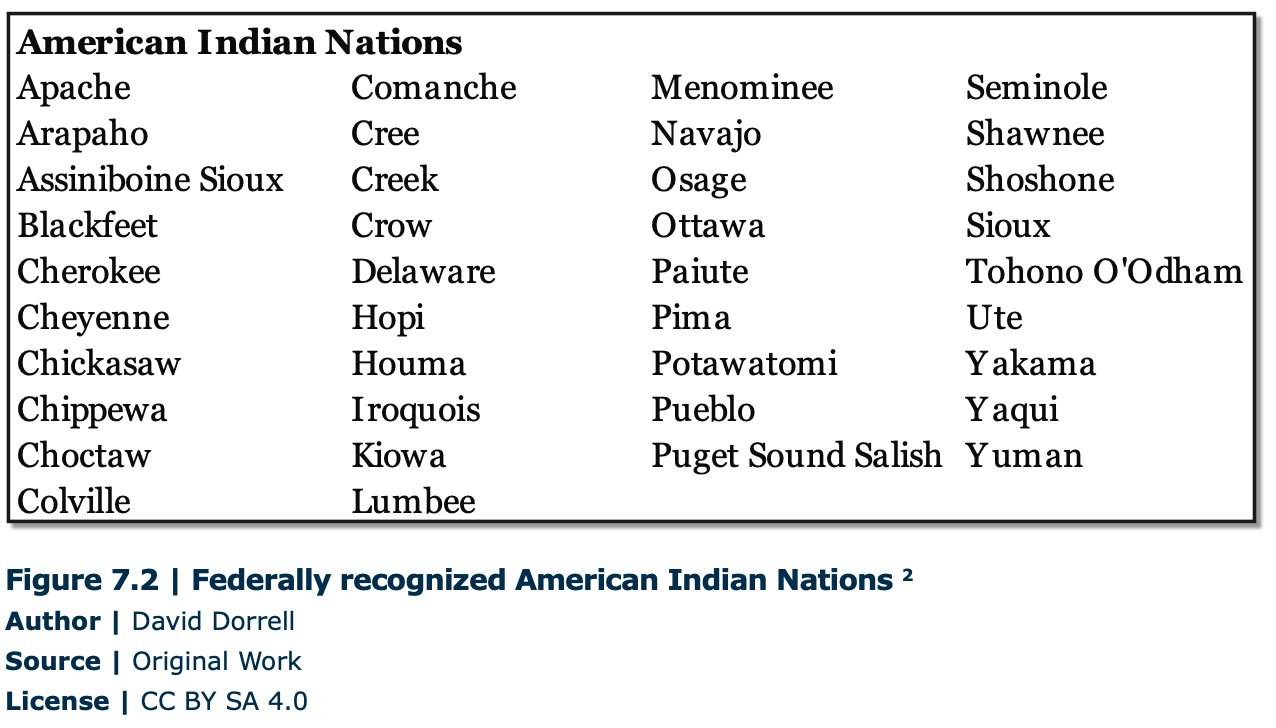7.1: What Are Ethnicity and Race?
- Page ID
- 38680
A common question asked in introductory geography classes is “What is ethnicity and how is it different than race? The short answer to that question is that ethnicity involves learned behavior and race is defined by inherited characteristics. This answer is incomplete. In reality, both race and ethnicity are complex elements embedded in the societies that house them. The relationship between race, ethnicity and economic class further complicates the answer.
Other students have asked, “How is this geography? Ethnicity and race have strong spatial dimensions. Both races and ethnicities have associated places and spatial interactions. A person’s ability to navigate and use space is contingent upon many factors- wealth, gender, and race/ethnicity. Anything that sets limits on a person’s movement is fair game for geographic study. Numerous geographic studies have centered on the sense of place. Race and ethnicity are part of a place. Signs are written in languages, houses have styles, people wear clothing (or not!) and all of these things can indicate ethnicity.
7.1.1 The Bases of Ethnicity
Ethnicity is identification through language, religion, collective history, national origin, or other cultural characteristics. A cultural characteristic or a set of characteristics is the constituent element of an ethnicity. Another way of thinking of an ethnicity is as a nation or a people. In many parts of the world, ethnic differences are the basis or political or cultural uprisings. For example, in almost every way the Basque people residing on the western border between France and Spain are exactly like their non-Basque neighbors. They have similar jobs, eat similar foods, and have the same religion. The one thing that separates them from their neighbors is that they speak the Basque language. To an outsider, this may seem like a negligible detail, but it is not. It is the basis of Basque national identity, which has produced a political separatist movement. At times, this movement has resorted to violence in their struggle for independence. People have died over the relative importance of this language. The Basques see themselves as a nation, and they want a country.
The ethnicities of dominant groups are rarely ever problematized. Majority ethnicities are considered the default, or the normal, and the smaller groups are in some way or another marginal. Talking about ethnicity almost always means talking about minorities.
There are three prominent theories of Ethnic Geography: amalgamation, acculturation, and assimilation. These theories describe the relation between majority and minority cultures within a society. Amalgamation is the idea that multiethnic societies will eventually become a combination of the cultural characteristics of their ethnic groups. The best-known manifestation of this idea is the notion of the United States as a “melting pot” of cultures, with distinctive additions from multiple sources.
Acculturation is the adoption of the cultural characteristics of one group by another. In some instances, majority cultures adopt minority cultural characteristics (for example the celebration of Saint Patrick’s Day), but often acculturation is a process that shifts the culture of a minority toward that of the majority.
Assimilation is the reduction of minority cultural characteristics, sometimes to the point that the ethnicity ceases to exist. The Welsh in the United States have few, if any, distinct cultural traits.
When we looked at the previous chapters- Language, Religion, and now Ethnicity, we have explored subjects that are often the core of a person’s identity. Identity is who we are and we, as people, are often protective of those who share our collective identity. For example, ethnicity, and religion can be closely tied, and what can appear as a religious conflict may be in fact a politicized ethnic disagreement or a struggle over resources between ethnicities that has become defined as a religious war. Muslim Fula herders and Christian farmers in Nigeria aren’t battling over religious doctrine; they’re two different peoples fighting for the same land and water resources.
One of the enduring ideas of modern political collectives is that we consider everyone within the boundaries of our country as “our group.” The reality has not lived up to that concept, however. Many modern countries are wracked by ethnic struggles that have proven remarkable resistant to ideas of ethnic or racial equality.
7.1.2 Race
The central question around race is simple: “Does race even exist?” Depending on how the question is framed, the answer can be either yes or no. If race is being used in a human context in the same way that species is used in an animal context, then race does not exist. Humans are just too similar as a population. If the question is rephrased as, “Are there some superficial differences between previously spatially isolated human groups?” then the answer is yes. There are genetic, heritable differences between groups of people. However, these differences in phenotype (appearance) say very little about genotype (genetics). Why is that? The reality is that human beings have been very mobile in their history. People move and they mix with other groups of people. There are no hard genetic linesbetween different racial categories in the environment. As a consequence of this, racial categories can be considered socially constructed.
7.1.3 How are ethnicity and race different?
People tend to have difficulties with the distinctions. Let’s start with the easiest racial category in the United States- African American. Most people understand that the origin of the African American or Black population of the United States is African. That is the race part. Now, the ethnic part appears to be exactly the same thing, and it almost is, but only for a particular historical reason. If Africans had been forcibly migrated by group, for example large numbers of BaKongo or Igbo people were taken from Africa and brought to Virginia and settled as a group, then we would be talking about these groups as specific ethnicities in the same way we talk about the Germans or Czechs in America. The Germans and Czechs came in large groups and often settled together, and preserved their culture long enough to be recognized as separate ethnicities.
That settlement pattern did not happen with enslaved Africans. They were brought to the United States, sold off effectively at random, and their individual ethnic cultures did not survive the acculturation process. They did, however, hold onto some general group characteristics, and they also, as a group, developed their own cultural characteristics here in the United States. Interestingly, as direct African immigration to the United States has increased, the complexity of the term African American has increased, since it now includes an even larger cultural range.
7.1.4 Specifically Ethnic
The United States is a multiethnic and multiracial society. The country has recognized this from the very beginning, and the U.S. Census has been a record of ethnic representation for the U.S. since 1790. Here are the current racial categories (Figure 7.1).

There are many ethnicities in the United States, and data are collected to a granular level, but in many ways, the ethnic categories are subsets of the racial categories. The idea is that race is a large physical grouping, and ethnicity is a smaller, cultural grouping. Thinking about the data this way helps understand why African American is both an ethnicity and a race (Remembering that there are African-Americans who come directly from Africa). Another, more complete example is the numerous ethnicities within American Indian. Within the race category of American Indian and Alaska Native are dozens of individual nations (Figure 7.2).

7.1.5 Hispanic Ethnicity in the United States
Since 1976, the United States government has required the collection and analysis of data for only one ethnicity: “Americans of Spanish origin or descent.” The term used to designate this ethnicity is Hispanic. It is a reference to the Roman name for what is now modern Spain. Hispanics, however are generally not Spanish; they are people who originate in one of the former colonies of Spain. Another term that is used is Latino, which is another reference to the Roman Empire. Both of these labels are very vague. Generally, people identify with the country of their ancestors (Mexico, Thailand), and not with a label generated by the Census Bureau for the purposes or recordkeeping.
Hispanics can be of any race. It is important to note that all racial and ethnic information is self-reported. This means that the person who decides if you are African American, Hispanic, or any other category is you. One final detail is thatnative people of hispanophone countries, even if they themselves do not speak Spanish, will often be considered Hispanic.


